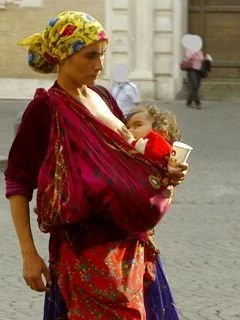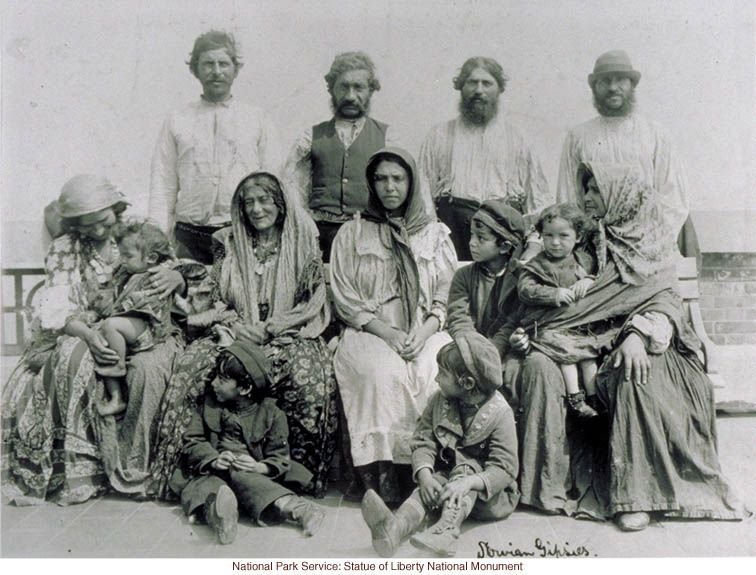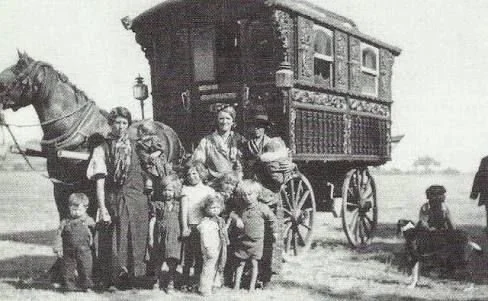Romani and Traveller Communities: Carried in Strength, Spirit, and Song
Across Europe and beyond, Romani and Traveller families have carried their babies not only in cloth, but in resilience. Through centuries of movement — sometimes by choice, often by force — the instinct to keep children close has never been lost. Woven into the fabric of daily life is a deep tradition of caregiving, where babies are held, slung, wrapped, and kept near as life moves forward.
This post honours the living, dynamic cultures of Romani and Traveller peoples — not as a single story, but as a collection of vibrant, diverse communities whose carrying practices reflect both cultural continuity and adaptation. We share these images with gratitude and respect, knowing that many representations of these families have been shaped by outsiders. Here, we aim to centre care, connection, and dignity.
While carrier styles vary widely depending on region, many families across Europe have used long woven cloths, shawls, or garments repurposed as slings to carry babies on the hip, chest, or back. Carriers are often improvised from what is at hand — dresses, scarves, or wraps — tied or tucked to hold a child snug against the body. These are practical, loving, and familiar, passed on through generations rather than taught by manuals. It is carrying as living knowledge — adaptable, fluid, and deeply human.
You may also see children held in arms, on hips, or riding older siblings' backs. These forms of carrying reflect the interwoven roles of extended family, where caregiving is shared and constant presence is valued.
The Romani people, often referred to as Roma, are an ethnic group with roots in northern India and a long history of migration through Europe, the Middle East, and the Americas. Romanichal (sometimes called English Gypsies), Kale communities in Wales and Finland, Calé in Spain and Portugal, and other groups represent distinct lineages within the wider Roma diaspora.
In parallel, Irish Travellers (Mincéir or Pavee), Scottish Travellers, and other nomadic communities form rich and resilient cultures with their own languages, traditions, and family structures. Though not ethnically Romani, many share similar histories of mobility, marginalisation, and cultural survival.
Despite centuries of discrimination, displacement, and misrepresentation, these communities have continued to carry their children with tenderness and pride. And still, their babies are carried. Still, their traditions continue. Still, family remains central.
Some images in this post reflect a painful history, including those involving public performance and poverty. Romani families were often forced to rely on street performance, including the now-condemned practice of bear-leading, as a means of survival. In such photographs, we see not just hardship, but also the strength of mothers who carried their babies through public scrutiny, marginalisation, and labour. These images are included with respect, not as spectacle, but as witness.
This post recognises not only the beauty of Romani and Traveller babywearing practices, but also the resilience required to preserve them. We acknowledge the weight of persecution and the deep pride of identity. To carry a child through such a world is an act of defiance, tenderness, and love.
To witness a mother or grandmother carrying a child is to see more than tradition — it is to glimpse the quiet strength of a people who have endured, adapted, and held fast to what matters most. We honour every family that carries forward their heritage, and every baby carried in arms or cloth, surrounded by kin and story.
A Romani woman walks through a European city square, carrying her toddler in a deep cloth sling tied over one shoulder. The wide, gathered fabric forms a pouch-like seat for the child, who breastfeeds comfortably while nestled close to her chest. The sling, a richly coloured woven wrap with decorative stitching, is paired with a floral headscarf and layered skirts — clothing often associated with traditional Romani dress. This style of babywearing allows for both mobility and responsive feeding, supporting a close connection between mother and child even in the midst of busy urban life. The image captures a moment of instinctive caregiving among the Romani people of Central and Western Europe, where carrying children in simple wraps or slings remains part of everyday practice for many families.
In this vintage photograph, a Roma (Romani) woman stands proudly with a traditional wooden cradleboard slung over her shoulder. Her skirt, gathered and patterned, her woven sandals, and her striped socks reflect the distinctive dress of Romani women in Eastern Europe and the Balkans during the early to mid-20th century.
The cradleboard, used for carrying infants, is decorated and padded to keep the baby secure while the mother moves through her day — whether traveling, working, or gathering with community. This form of baby carrying not only ensured the baby's safety and closeness but allowed mothers to remain mobile and active, essential in nomadic and semi-nomadic life.
With a warm, strong expression, this mother embodies the resilience and adaptability of Romani culture. The cradleboard itself becomes more than a practical tool; it is a symbol of continuity and care, connecting the youngest generation to a long, rich lineage of tradition, artistry, and survival on the move.
This haunting black-and-white image captures a Roma (Romani) mother and her children, likely in Eastern Europe in the late 19th or early 20th century. Her clothing is patched and worn, a testament to a life marked by poverty, migration, and resilience. She carries a small child on her back using a simple cloth tied across her shoulders, while holding a baby in her arms. At her side stands another young child, their gaze weary and guarded.
The mother’s face speaks of strength and quiet endurance, eyes set firmly ahead despite hardship. Her children are pressed closely to her body — a living shield against the uncertainty of the road. Among many Roma families, keeping children physically close has long been both a practical necessity and a deep expression of love and protection, particularly during times of displacement.
In this scene, babywearing is not only an act of nurture but also of survival. Each knot and wrap is improvised from what is available, embodying the resourcefulness of a mother who must keep moving yet hold her family together.
This portrait tells a story of maternal courage and unyielding devotion — a mother carrying not just her children, but the weight of ancestral struggles, hope, and the enduring thread of connection that binds them together no matter where the road leads.
A Romani mother stands with vibrant pride, her skirt lifted to reveal its full floral sweep. Dressed in bright, layered garments and a yellow fringed scarf, she is a vivid reflection of the joy and colour woven through many Roma traditions. Across her body, a long woven cloth has been tied from shoulder to hip, forming a snug, high carry for the baby nestled against her chest.
The baby’s legs are tucked in, their body fully enclosed by the fabric, with only a tiny foot and bundled cap peeking from the folds. The sling is tied with purpose and flair — fabric doubled and crossed for security, blending seamlessly with the family’s style of dress. This is babywearing as both function and expression — warm, beautiful, and deeply integrated into daily life. Beside her, a small child stands in admiration, her own headscarf tied with the same care, watching and touching the edge of her mother’s skirt.
A Romani family sits together for a formal photograph, likely taken during immigration processing at Ellis Island in the early 20th century. The image is held in the public archives of the National Park Service and originally labelled “Slovian Gypsies” — a term reflective of the period, but now understood to carry bias. Here, we recognise them with respect as a Romani family in transition, pausing for documentation as they arrive in a new country. The family forms a quiet circle of strength: four men stand behind, while three generations of women and children are seated in front. On either side, two mothers hold their children close — one cradling a toddler wrapped in cloth against her body. The shawls, long skirts, and layered clothing reflect both cultural tradition and practical travel dress.
A Romani or Traveller family poses for a relaxed group photo outside a wagon, likely somewhere in Western Europe in the early 20th century. Toward the right, a woman carries a toddler in a wide shawl slung around her shoulder, the child held securely at her hip. This image, informal and full of personality, reflects not just the practice of babywearing but the spirit of family connection — generations standing together, caregiving shared, and little ones always carried close.
A Romanichal Traveller family stands proudly beside their traditional Vardo — a horse-drawn wagon that served as both home and symbol of identity. The children are close, the mothers steady, and the horse, well-tended, stands as part of the family circle. Babywearing is not the focus of this image, but the theme of carrying — of holding, gathering, keeping family close — is unmistakable. These wagons were not just transport; they were spaces of care, connection, and continuity, passed from one generation to the next.
In a cobblestone street somewhere in Europe, a Romani woman stands with striking composure, her baby tied close against her chest in a soft cloth sling. The wrap crosses her back and loops over her shoulder, expertly knotted at the hip in a secure front carry. Her child leans into her body, arms draped outward, face calm despite the spectacle unfolding beside them.
She holds a tambourine in one hand. Behind her, a bear on a chain rears upright — a haunting image of the old practice of performing bears, once common across parts of Eastern and Central Europe. Romani families were often among those forced by poverty or social exclusion into public street performance as a means of survival.
This image is raw and layered: love and labour, motherhood and performance, dignity amid hardship. The baby is held close, as ever — not shielded from the world, but carried through it. For many Romani families, babywearing has never been a separate practice or parenting choice. It is simply life. Movement. Survival. Connection.
A note of gratitude and respect
We respectfully acknowledge and honor the individuals and communities depicted in historical images throughout this series. Many of these photographs were taken in times and contexts where informed consent as we understand it today was not sought or given, and some may have been created through coercion or exploitation.
We share these images with the deepest gratitude, not to romanticize or objectify, but to recognize and celebrate the strength, resilience, and wisdom of these cultural practices. We hold these ancestors and knowledge holders in our hearts and aim to represent their traditions with integrity, humility, and care.
We commit to continuing to learn, listen, and uplift the voices of contemporary community members and descendants, and we welcome guidance on the respectful sharing of these images.








